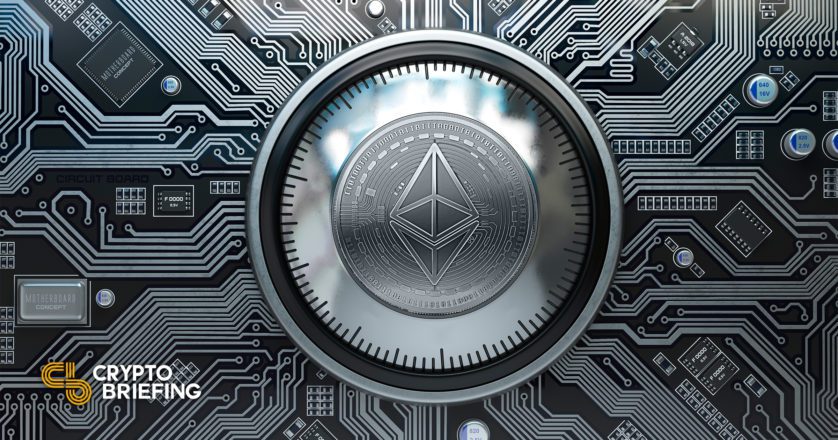Opinion: 2022 Is Ethereum's Biggest Year Yet
2022 is a make-or-break year for Ethereum. Can the second-ranked blockchain deliver on its promises?

Key Takeaways
- Ethereum is expected to complete "the Merge" to Proof-of-Stake in the coming months.
- The Merge will see Ethereum become 99.95% more energy efficient, while ETH is likely to become a deflationary asset.
- Ethereum needs to move to Proof-of-Stake and gain Layer 2 traction this year to avoid losing ground to its competitors.
Share this article
With the Merge to Proof-of-Stake on the horizon, 2022 is a crucial year for Ethereum.
Ethereum Prepares for the Merge
This time last year, as the big bull run was getting going, many crypto enthusiasts talked about how 2021 would be “Ethereum’s year.” The narrative took hold thanks to the mainstream NFT explosion and popular EIP-1559 update, but by the time Ethereum had started burning ETH, several top “alternative Layer 1s” (i.e. Solana, Avalanche, and Terra) had stolen Ethereum’s thunder.
Now, things look a little different. While the dust is still settling on the 2021 market mania, and newer smart contract networks are either posting lows or caught in multi-million dollar bets over their possible implosion, all eyes are on Ethereum once again. EIP-1559 has hit 2 million ETH burned and there’s now over 10 million ETH staked on the Beacon Chain, but that’s not really what enthusiasts are paying attention to right now. At least, not entirely.
The bigger news of the last few days is that Ethereum has completed its Kiln testnet. Kiln was the last Merge testnet before public testnets upgrade, and it quietly transitioned from Proof-of-Work to Proof-of-Stake last week.
Ethereum has faced criticism for its long delays in the past—Vitalik Buterin memorably got ahead of himself by estimating that the network would be ready to move to Proof-of-Stake years ago—but for the first time, it feels like the tentative June 2022 target date may actually be in reach.
Now you might be wondering why Ethereum moving to Proof-of-Stake is so significant. After all, practically every other chain barring Bitcoin already uses validators rather than miners to achieve consensus; the likes of Tezos have used their energy efficiency as a selling point for a while now.
Firstly, Ethereum is bigger than every other smart contract network combined. It still dominates the Layer 1 landscape even after the SOLUNAVAX rally, so the impact of a move like this shouldn’t be underestimated. It’s believed that Proof-of-Stake will make Ethereum 99.95% more energy efficient, which is something that NFTs—arguably Ethereum’s top use case today—will need to gain wider popularity (since the 2021 boom, rightly or not, onlookers have lumped the red hot technology in with climate change).
But just as importantly, ETH emissions will plummet once the merge completes. In order to pay miners, the ETH supply currently inflates by about 4% annually. With Proof-of-Stake, emissions are set to come in at closer to 1%. And remember EIP-1559? Because it’s burning so much ETH, the supply could end up shrinking once emissions drop.
Despite (or perhaps because of) this being a critical year for Ethereum, it’s not been without internal drama. Last week, the Ethereum Foundation’s dev team lead Péter Szilágyi caused a stir when he posted a tweet storm complaining of the network’s increasing “complexity,” complete with his frustrations with having to piece together “a broken network” and a meme imagining a future in which the network “got destroyed.” The post led to speculation over whether Szilágyi was planning an exit and ongoing discussions over how much Ethereum’s AllCoreDevs should earn (by crypto standards, they’re surprisingly underpaid). Most Ethereum fans want to see the devs earn mid to high six-figure salaries that top the most lucrative Big Tech jobs, which doesn’t seem unreasonable given the size of the thing. As an ETH holder, I’m obviously hoping the issues get resolved. As I’ve said in the past, we need to protect the devs, and paying them a competitive wage is one way of doing that.
The market has had a rocky start to the year, and so far it feels like the Merge has got lost in the noise (it also doesn’t help that Ethereum is known for its delays). Fans say that the event is not priced in yet, but that should change in the run-up. Where so much was happening across the space last year, Ethereum now has a clear opportunity to take center stage. One caveat, though: it will need to happen in the next few months. Further delays could cause the market to lose faith in Ethereum at a crucial time.
Similarly, while gas fees are cheaper than they’ve been in what feels like forever, Layer 2 needs to take off in earnest. So far, Arbitrum is leading the efforts, but its total value locked is nothing compared to the billions deployed across DeFi on Ethereum. Layer 2 needs to feel easy to convince users to migrate, but it’s not there yet. Here’s hoping that StarkWare’s StarkNet can live up to the expectations.
Compared to this time last year, there hasn’t been all that much to get excited about in recent weeks, what with the weak price action, decreasing trading volumes, and of course all the geopolitical turmoil and macroeconomic uncertainty. But for Ethereum diehards, 2022 is easily the network’s most important year yet. Assuming the internal problems get solved and Proof-of-Stake happens without a hitch, it’s difficult to see Ethereum coming close to death like it did in the last bear cycle. In fact, I’m placing my bets on the opposite outcome.
Disclosure: At the time of writing, the author of this piece owned ETH and several other cryptocurrencies.
Share this article
